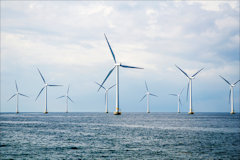Earlier this month, Dominion Energy announced that it had commenced construction of the $300 million Coastal Virginia Offshore Wind (CVOW) project, which entails building two experimental wind turbines and a half-mile electrical conduit to connect them to the electric grid. Construction of the two turbines at such a cost cannot be justified by the paltry amount of electricity they will generate by themselves. Rather, according to Dominion, the demonstration project paves the way for a large-scale exploitation of wind power off Virginia Beach. If Dominion proceeds with commercial-scale development, the $1.1 billion project will generate 2,000 megawatts of zero-carbon energy, enough to power 500,000 homes.
“As the first deployment of commercial-scale offshore wind turbines in federal waters,” said Governor Ralph Northam in a press release at the time, “I am thrilled that Virginia’s project will help determine best practices for future offshore wind construction along the East Coast.”
The question has arisen in this blog: Why the need for the two experimental turbines? Europeans have been extracting wind power from turbines in the North Sea, which is known for its powerful storms. Haven’t they already demonstrated the ability of wind turbines to hold up under extreme weather conditions? What can we learn, and can we learn it in time to inform the construction of the larger project?
I posed several questions to Dominion regarding the necessity of the two experimental turbines. Spokesman Rayhan Daudani responded as follows:
What “best practices” and/or technologies are being tested?
You may want to check with the Governor’s office to see what best practices the Governor was referring to [in his press release]. However, since Dominion Energy is the first, and currently only, permitted wind project in federal waters, it established precedence for future offshore wind projects permitted by the Bureau of Ocean Energy Management. This includes establishment of processes / procedures for the permitting, design installation, and commissioning of the first turbines in federal waters
How long will it take to yield meaningful results that can be applied to future wind turbines off the Virginia coast?
We are learning each day and our results are ongoing. Specific to the wind resource, we expect the turbines to be in operation in 2020. One-to-two years of data will help us confirm expected capacity factors and other variables we can apply to future wind turbines.
Is the building of additional turbines off the Virginia coast contingent upon obtaining positive results from the experimental turbines?
These turbines will provide valuable information for the commercial wind energy lease area in many ways which are expected to be positive, all of which will inform our path forward on future installations. This includes information about the wind resource, permitting process, construction, installation and the operations experience.
Are other states dealing with comparable issues, or are the questions to be answered by the experimental turbines unique to Virginia conditions?
There are unique questions to be answered by these turbines, such as site specific wind data and installation criteria, which varies from location to location. Each state or project deals with these differently. As previously mentioned, the BOEM experience will apply to all projects – and we have a front row seat in helping shape how projects will define and implement the requirements.


Leave a Reply
You must be logged in to post a comment.